Glossary
Ruby Glossary
The details and depth of the natural ruby world would not be complete without a glossary to help further explain important terms and concepts about the gemstone and its many incarnations.
Alluvial deposits: loose, unconsolidated soil or sediments that have been eroded, reshaped by water, and deposited in non-marine setting.
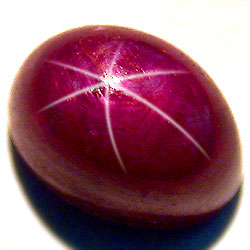
Amulet: an ornament or small piece of jewelry thought to give protection against evil, danger, or disease.
Asterism: a term that refers to the stars that can be seen in some cabochon-cut beryls.
Blemish: a gem characteristic or irregularity that is confined to the surface of the stone.
Bi-Color ruby: ruby gemstones that contain two colors as a result of color zoning.
Brilliance: describes the amount of light reflected back to the viewer from the interior of a cut stone.
Briolette: a teardrop-shaped gem with triangular facets and no girdle.

Cabochon: a smoothly rounded and polished stone with a domed crown and a flat or curved base.
Calibrated sizes: gemstones cut to certain sizes to fit standard mounts.
Cleavage: breaks or cracks in a gemstone parallel to lines of atomic weakness within the crystal framework.
Color zoning: portions of a stone that exhibit different colors due to variable growth conditions experienced during crystal formation.
Commercial quality: average quality, mass-marketed gemstones, as opposed to high-end gemstones. These are the vast majority of gemstones available on the market.
Corbeille: a 19th century tradition where the groom presents the bride with a marriage gift—often a casket of jewels.
Crown: the top of the gem above the girdle.

Culet: the tiny facet or point at the very bottom of a cut gemstone.
Designer cuts: unique and artistic stone cuts that do not have traditional or specific facets, shapes, or styles.
Dichroic: a term that describes gems that exhibit only two pleochroic colors.
Dispersion: the breakup of white light into spectral colors. Diamonds have high dispersion; emeralds have low dispersion.
Durability: a gem’s natural ability to withstand heat, chemicals, and wear.
Enamel work: the fusion of colored glass onto metal. Different kinds of enameling include basse-taille, champlevé, cloisonné, plique-à- jour, and sgrafitto.
Extinction: areas of a transparent gemstone where the body color looks very dark to black. This can be caused by improper cutting.
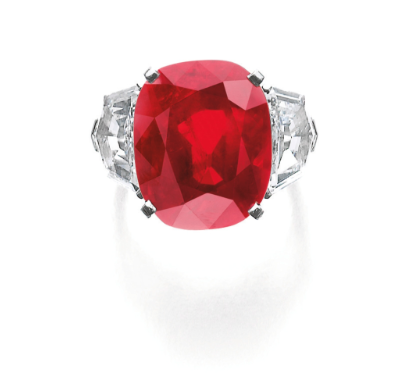
Eye-clean: gemstones with inclusions that are only visible with the aid of magnification.
Facet: a flat polished surface on a cut gemstone.
Feathers: small inclusions in the surface of a gemstone created during crystal formation.
Finishing: adding the polish and symmetry to a fashioned gemstone. This term also refers to the process of cleaning and polishing an item of jewelry— where tool marks are removed, edges are smoothed, luster is achieved, or other surface effects are applied.
Fluorescence: this feature refers to an object’s ability to emit visible light when it is exposed to radiant energy. In rubies, this is expressed as the ability to fluoresce red in daylight.
Flux healing: a process involving heating a gemstone and infusing a chemical flux that once it cools, has facilitated corundum recrystallization within the fissure, filling fractures or cavities to improve clarity, luster, and durability.
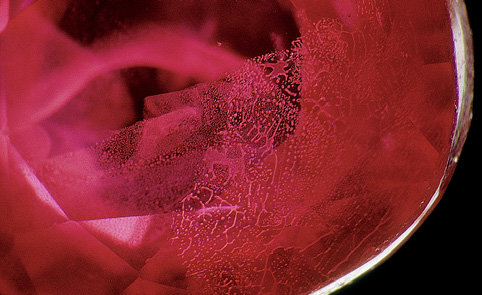
Fracture: breaks or cracks in a stone that are not along cleavage planes.
Fracture filling: a process in which the fractures in a gem are concealed by a variety of fillers thus improving the apparent clarity.
Gem quality: used to describe a gemstone of extremely fine and rare quality.
Girdle: the junction between the crown and pavilion of a stone, often corresponding to the area of a gemstone with the largest dimension.
Habit: the characteristic shape or form of a mineral crystal.
Hardness: a gemstone’s resistance to scratching and abrasion as measured by the Mohs Hardness Scale.
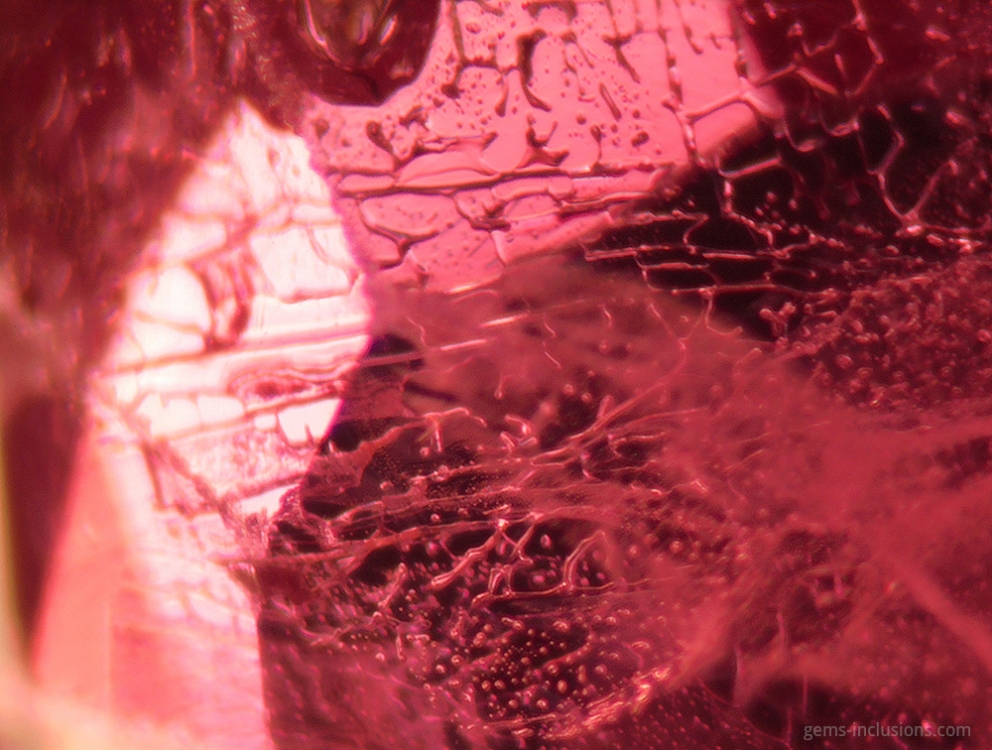
Heat treatment: the process of heating gemstones to improve color, remove color zoning, and improve clarity.
Hue: a gemstone’s basic color, as in red rubies.
Igneous rock: rocks formed by the crystallization of molten magma.
Inclusion: a feature of a gem such as a feather, a crystal, or a cloud that reaches the surface or is enclosed within the stone. Inclusions can have both positive and negative effects on the value of the gem.
Karat: a unit of purity of gold. One karat is 1/24 pure, so 24 karat is pure gold. Karat is abbreviated as “K” or “Kt.” Outside the U.S. “karat” is often spelled “carat,” but this should not be confused with the unit of weight for gemstones also called measured in “carats.”
Lariat: a very long necklace (usually wrapped around the neck two or more times) with unattached ends that are tied or knotted in different ways on the chest.

Lapidary: a cutter, polisher, or engraver of precious stones, usually other than diamonds.
Lavalier: a necklace with two pendants of unequal length suspended from it—also called a negligee necklace. Lavalier is also used as a generic term to describe necklaces with a drop pendant.
Lithification: the process of converting sediments to solid rock usually through cementation and/or compaction.
Luster: the surface appearance of a material in reflected light– in emerald, the luster is typically vitreous.
Magma: molten rock, including any dissolved gases and crystals, usually found at great depth in the Earth.
Melée: very small faceted gemstones that are often used in pavé settings.
Metamorphic rock: rock formed by the transformation of pre-existing solid rock deep within the Earth via a process involving heat, pressure, and/or chemically active fluids.

Mixed cut: a cutting style that combines brilliant and step cutting styles.
Mounting: the precious metal part of an item of jewelry before the stones are placed into it.
Native cut: an informal gemstone cut that is determined by the natural shape, color, and clarity of a rough ruby crystal.
Natural ruby: a ruby crystal that has been developed in the earth, not synthetically created or treated in a lab.
Opaque: the quality of not allowing the transmission of light through a gemstone.
Parure: a matched set of jewelry pieces. A popular style through the 19th century, a complete parure consisted of two matching bracelets, a necklace, earrings, and a brooch.
Pavilion: the lower part of a gem below the girdle.
Pegmatite: a special type of igneous rock composed mostly of very large crystals of rock-forming minerals and containing a high percentage of rare and unusual elements.

Phenomena: an unusual optical effect in a gemstone, including chatoyancy and asterism.
Pigeon’s blood red: the term commonly used to define the most highly desired color of ruby. It is a deep, blood red color.
Pleochroic: describes a gem that exhibits different body colors when viewed from different crystal directions.
Porosity: a metal defect that appears as pits or holes in the surface.
Primary deposits: gemstones that are found in situ, or contained within their host rock.
Proportion: the overall shape (angles and dimensions) of a fashioned gemstone.
Refractive index: a number that indicates the property of light refraction in a material. In gemology, the refractive index is highly diagnostic and gives an indication of the optical density of a gem relative to that of air.

Rough: a natural, uncut gemstone crystal.
Saturation: the strength or intensity of a color (hue).
Sautoir: long chains or ropes of pearls or beads that have tassels at the ends.
Secondary deposits: gems that are deposited away from their primary source.
Sedimentary rock: rock formed from weathered products of pre-existing rocks that have been transported, deposited, and lithified.
Simulant: natural or artificial materials that imitate the appearance of a gem without possessing any of its chemical or physical properties.
Solder: a metal or metal alloy used to join other metals together.
Step cut: a popular cutting style with square and rectangular facets.
Synthetic: a man-made gemstone that has the same composition and structure its natural component.
Tone: the darkness or lightness of a color (hue).
Torsade: a twisted, multi-stranded short necklace or bracelet usually made of beads or pearls.
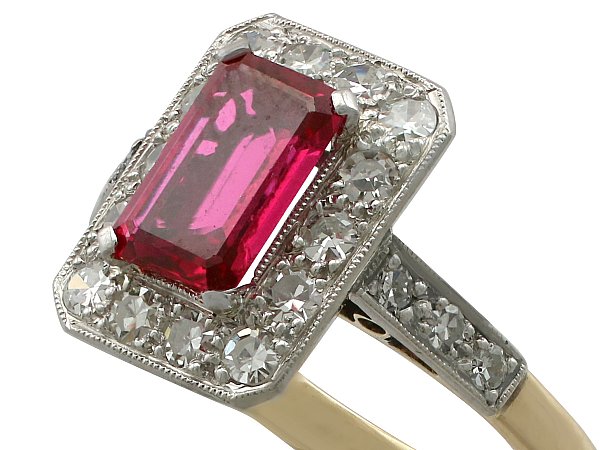
Toughness: a gemstone’s resistance to chipping, cracking, and breaking.
Trace elements: atoms in a gem that do not constitute part of its basic chemical composition, but occur as minute impurities. Trace elements determine the color of some gemstones, including ruby.
Translucent: the effect of a gemstone allowing transmitted light to pass through, but objects cannot clearly be seen on the other end.
Transparency: the effect of a gemstone allowing transmitted light to clearly pass through so that objects can be seen clearly on the other end.
Untreated ruby: a ruby that has not undergone any heat or chemical treatments to improve its color or clarity.
Windows: portions of a transparent gemstone where the body color appears to be see-through or watery. This can be caused by improper cutting.
